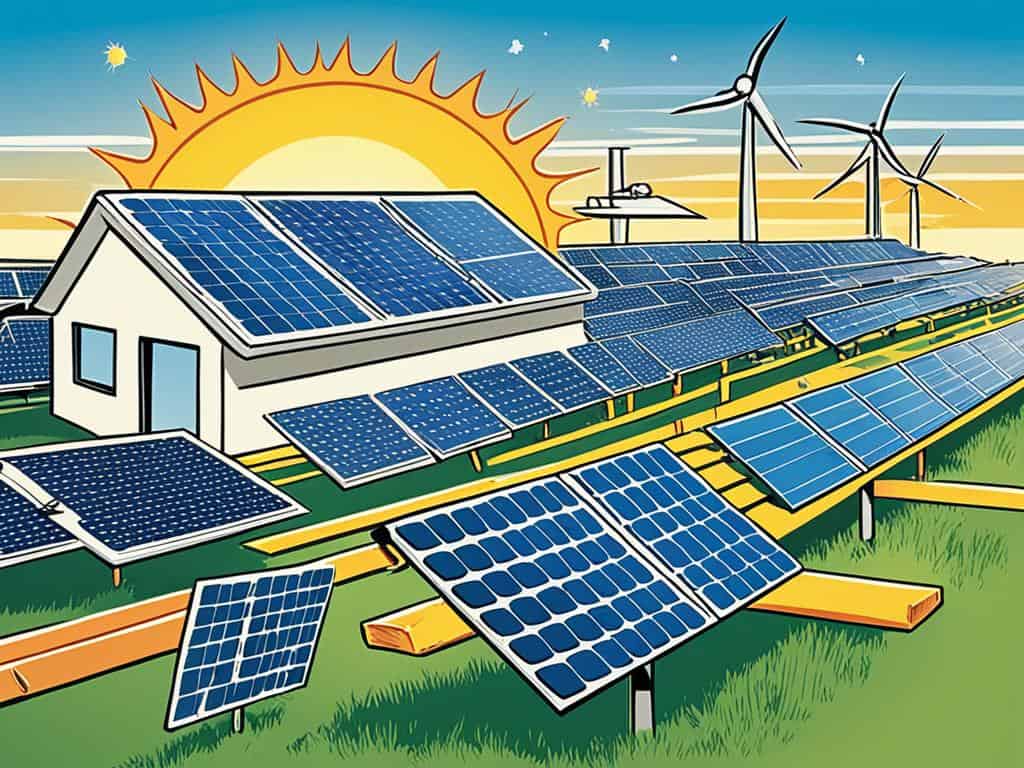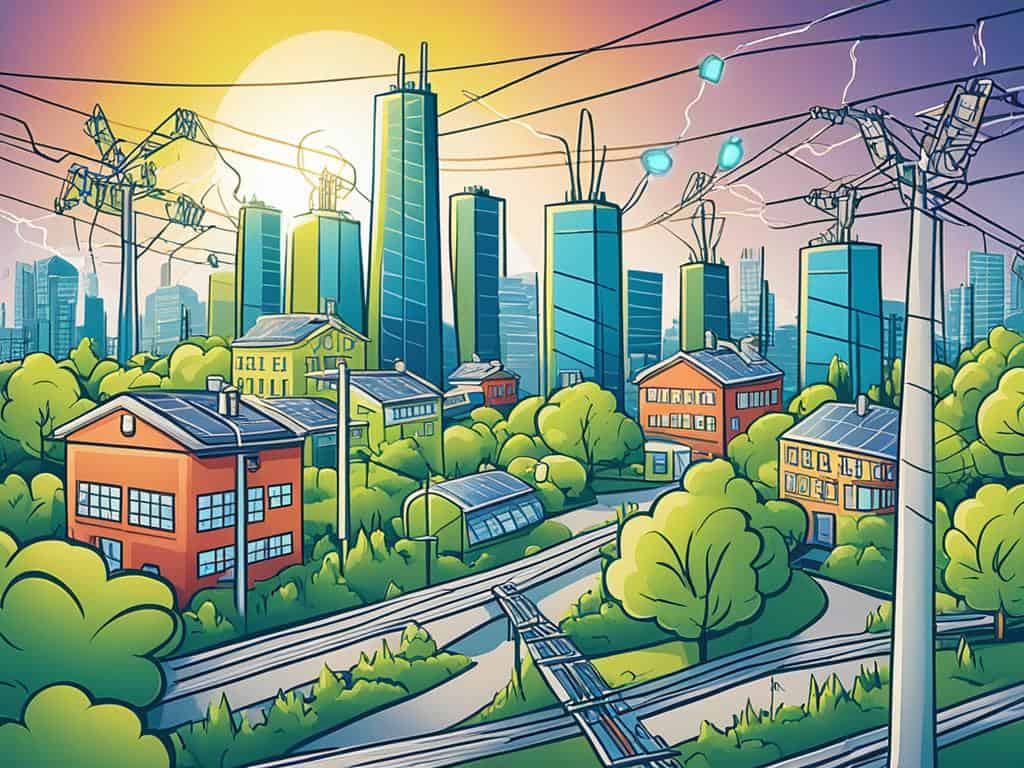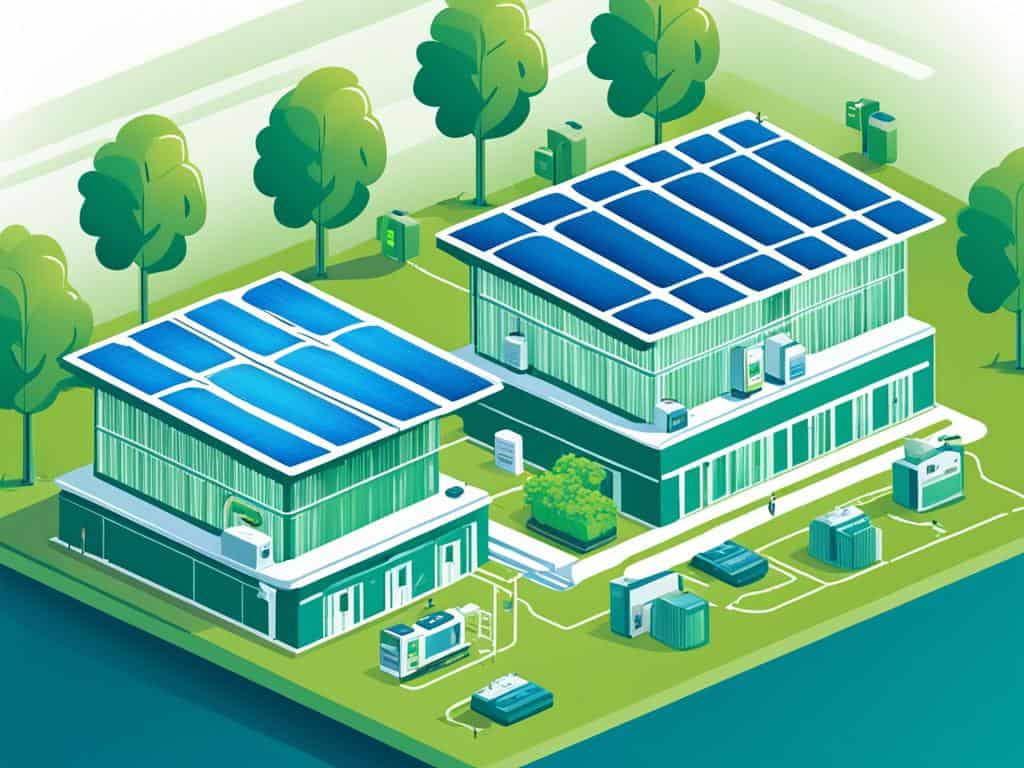Grid Connected System: Seamless Power Integration
Explore the benefits of a grid connected system for seamless integration with India’s electricity grid, enhancing renewable energy adoption.

Imagine a world where every home rooftop can produce energy. How does India tap into the sun’s endless energy for a better tomorrow? The key is a mix of rules and technology that allows a smooth connection of power through grid systems. In India, moving to solar power is not only good for the planet—it’s also a wise financial decision.
In India’s push for cleaner energy, your home can help the nation’s green energy goals. Almost 35% of global electricity is from renewable sources now. This means you can turn your house into a little power plant. There are many rules and systems in place to make sure these connections are safe, reliable, and efficient.
At the forefront of this green movement is Fenice Energy. They offer solutions that make the most of things like bi-directional metering to help homeowners. Let’s explore how this tech lets you use clean energy at home and help the overall energy grid become stronger and more balanced.
Key Takeaways
- IEEE 1547-2003 and UL 1741 standards form the technical foundation ensuring the safety and functionality of grid-connected renewable systems.
- With National Electrical Code compliance, homeowners can be confident in the safety of their electricity grid connections.
- State pre-certification of equipment streamlines the grid connection process, fostering faster adoption of renewable sources like solar power.
- Net metering policies not only make solar adoption more enticing for residents but also contribute to India’s visionary energy goals.
- Fenice Energy’s role in India’s push towards clean energy, includes facilitating grid connections and energy management, making the transition to renewable sources hassle-free for homeowners.
The Revolution of Renewable Energy and Grid Integration
Photovoltaic systems are changing how we produce energy. They are key to a sustainable future. India’s power grid showcases the growth of renewable energy.

The Rise of Photovoltaic Systems
Solar power has grown five times in eight years. This growth shows a major move toward clean energy. Nowadays, solar power is a big part of new energy projects.
Rooftop solar installations and large solar farms are becoming common. This shows how much solar energy use is expanding.
Impacts on Climate with Clean Energy Solutions
More solar panels mean less greenhouse gas emissions. Switching from old energy sources to solar helps the planet. This change slows down climate change and moves us toward a cleaner world.
Scaling of Renewable Energy and India’s Commitment
India is working hard on using more solar energy. Strengthening its power grid helps use more clean energy. This effort is key to handling the energy from the sun and wind.
| Technology | Market Share (2022) | Efficiency Growth | Cost Consideration (2021) |
|---|---|---|---|
| Crystalline Silicon Solar Cells | Over 90% | Steady Improvements | Dominant with Lower Costs |
| Perovskite Solar Cells | Emerging | 3.8% (2009) to 25.7% (2021) | Competitive Potential |
| Concentrated Solar Power (CSP) | Less Prevalent | Consistent | Twice the Cost of PV |
| Photovoltaic (PV) Systems | Widely Adopted | Constant Innovation | Most Economical |
This table shows different solar technologies and their details. Fenice Energy offers the latest in solar tech for India’s grid. They focus on custom clean energy for homes.
Updating our power systems is a big task. It includes better grids and dealing with cyber threats.
Using more clean energy, like solar panels, starts a new energy era. Today’s challenges will lead to tomorrow’s solutions.
Understanding Grid Connected Systems in Power Generation
Grid connected systems play a big part in making power generation efficient today. By using distributed energy resources, they improve how energy is managed. This allows a great balance of energy use and production. Keeping renewable energy systems in line with power grids needs following specific standards and rules.
The IEEE 1547-2003 standard is key for grid-connected operations, covering a range of renewable energy systems. It helps make sure these systems boost power generation efficiency. This leads to a better way of sharing energy.
UL 1741 certifications show that inverters meet important standards like IEEE 1547. These are not just markers of meeting standards; they make systems reliable. This builds trust between power providers and consumers, helping more people use renewable energy.
Laws are very important for grid-connected systems. For example, the Public Utility Regulatory Policy Act (PURPA) of 1978 makes it a rule for power companies to buy extra power from small green energy producers. This encourages the use of grid connected systems by making sure producers get paid fairly.
Net metering is a big feature of grid-connected systems. It lets consumers get credit for extra electricity they give back to the grid. This is great for resources with changing outputs, as consumers can save their extra power for later use.
Even with their benefits, grid-connected systems have costs for everyone involved. Power companies might need a lot of insurance. They might also charge extra fees for having backup power. Keeping these systems safe and working well requires strict rules about power quality and metering.

Some states are making it faster to connect to the grid by approving certain equipment beforehand. Net purchase and sale setups use advanced metering to track electricity moving between the producer and the grid accurately.
The U.S. electricity grid has changed a lot from the early 1900s, with over 4,000 separate utilities back then. Now, three major interconnections make up the U.S. power system. They are managed by authorities ensuring reliable electricity supply.
The smart grid has made our electrical systems more reliable. It makes the grid ‘smart’, reducing losses and fixing problems quickly. This supports grid connected systems with lots of distributed energy resources.
Looking ahead, grid connected systems face hurdles like adding new transmission lines and making sure costs are shared fairly. They also have to be kept safe from physical and cyber threats. All of these are vital for a system that supports steady energy supply and encourages innovation.
Fenice Energy, committed to clean energy, sees the value of these systems in India’s energy future. Integrating grid-connected systems is crucial for better energy efficiency and management. This is key to a lasting, green future.
Advanced Inverter Technology – The Backbone of Grid Connections

Inverter technology is key to efficient power in renewable energy today. Micro-converters connect in series, changing how solar panels work. Fenice Energy leads with these techs, making solar systems for homes and businesses that set the standard.
Series-Connected Micro-Converter Working Principles
Micro-converters play a big role in making solar energy usable. They control each solar panel separately for better power generation. This is great for areas where shade might lower energy collection.
Cost-Efficiency and Energy Management in Modern Inverters
Today’s inverters are both cost-effective and efficient. They use advanced techniques to make solar systems simpler and cheaper. Fenice Energy uses these to offer inverters that grow with your energy needs, keeping management strong.
Fenice Energy’s Approach to Inverter Integration
Fenice Energy focuses on integrating inverters smoothly with our changing world. They use smart tech to blend inverter technology with power generation seamlessly. Fenice leads in making energy solutions that are robust and work together well.
Energizing the planet with clean solutions is Fenice Energy’s goal. They are key in developing next-gen power systems. Their work on advanced inverters helps us move to a cleaner, empowered future.
Smart Grid Integration and Distributed Energy Resources
India is moving towards a sustainable energy system with Smart Grid tech and Distributed Energy Resources (DERs). Fenice Energy focuses on these solutions. They make energy management and grid stability better. They also help blend renewable energy into the existing grid. The IEEE 1547-2003 standard outlines the rules for connecting to the grid. It shows why Smart Grid integration is crucial for the power sector’s growth.
Smart Grid Benefits to Renewable Integration
Smart Grid systems, with UL 1741 certified parts, improve devices like inverters. This makes renewable energy systems work better together. Fenice Energy creates solutions that let people use energy smarter. People become both consumers and producers of electricity. Smart Grids reduce energy loss and follow NEC safety standards. They push clean energy usage.
Also, it makes adding renewable energy easier for Indian homes and utilities. This is thanks to simpler contracts and pre-certifications for equipment.
The Role of Distributed Energy Resources in Grid Stability
Smart Grids offer more stable power supplies, thanks to Distributed Energy Resources. Fenice Energy uses resources like rooftop solar panels. This reduces India’s reliance on old power sources and makes the grid stronger. DERs and Smart Grids together offer real-time monitoring and quick fixes during outages.
This helps consumers get reliable, clean electricity. Utility providers cut costs and manage assets better. A self-healing grid balances energy production and use efficiently.
With careful planning and everyone’s effort, Smart Grid and DER are changing India’s energy scene. Fenice Energy is leading this change. Their goal is a greener and more sustainable power system in India.
FAQ
Q: How do grid connected systems support seamless power integration?
A: Grid connected systems make it easy to add solar power to our main electricity supply. They let renewable energy flow smoothly to users, making sure we have constant power. These systems can even send extra energy back to the grid, adding more power for everyone.
Q: What role do photovoltaic systems play in renewable energy adoption?
A: Photovoltaic (PV) systems lead the way in using renewable energy. They turn sunlight into electricity in a clean, sustainable way. They’re getting better and cheaper, helping us use less fossil fuel and cut down on harmful gases.
Q: How does the shift to clean energy solutions impact the climate crisis?
A: Shifting to clean energy like solar and wind is key to fighting the climate crisis. These solutions don’t release harmful gases, so they help reduce global warming. This is a big step towards a sustainable future for our planet.
Q: How is India scaling up its renewable energy capacity?
A: India is increasing its use of renewable energy with new investments and policies. It’s improving its power grid to handle more solar energy. This helps India move to a cleaner economy and fight climate change globally.
Q: What are the benefits of advanced inverter technology in grid connected systems?
A: Advanced inverters are key in these systems because they efficiently turn DC from solar panels into AC for our homes. They ensure each solar panel works at its best, increasing energy produced. This makes the systems more valuable and cheaper over time.
Q: What is the significance of smart grid integration with renewable energy sources?
A: Smart grid integration is important as it makes the electricity grid more efficient and stable. Smart grids adjust to energy needs and include more renewable sources. This leads to a stronger and greener energy system.
Q: How do distributed energy resources contribute to grid stability?
A: Distributed energy resources are small, local power sources like solar panels. They help by generating power close to where it’s used, lessening the strain on our main grid. This method helps meet our energy needs more flexibly and keeps the grid stable.
Q: Why is Fenice Energy’s approach to inverter integration considered innovative?
A: Fenice Energy is known for its creative way of matching inverters to specific home and business needs. By using advanced technology, they get the most out of each solar panel. This boosts system performance and supports clean energy use.


